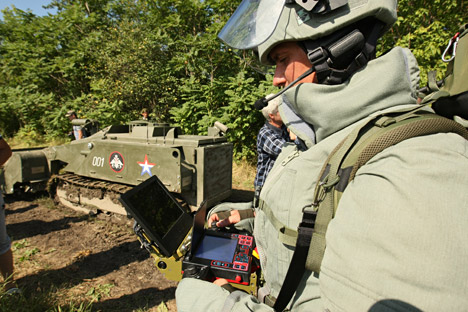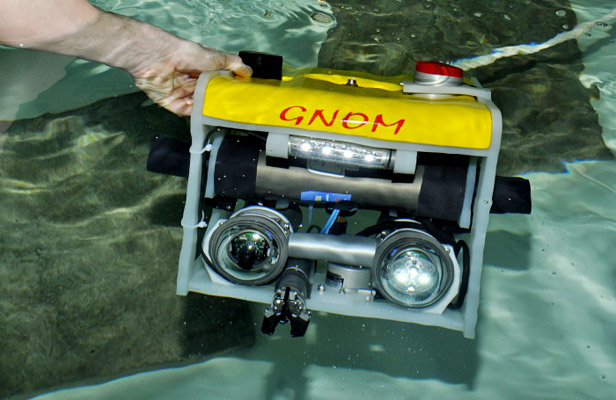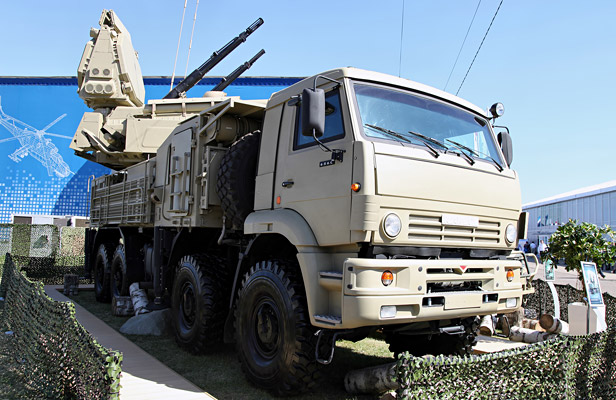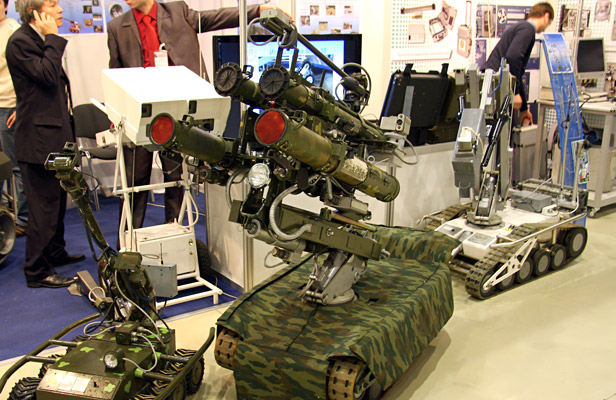
A combat engineer of the Southern Military District's Engineers Corps wears new protective gear and holds console for operating the remote-controlled Uran-6 robotic system.
Said Tsarnaev/RIA NovostiRobots serving in the Russian army might appear like a scene from Hollywood or Mosfilm studios, but it is part of a growing reality. Several technical systems geared to replace people already exist and are being used, like drones, demining robots and reconnaissance units.
The Gnom submersible vehicle was tested in 2005, performing underwater exploration tasks and mine clearance. The Pantsir-S1 self-propelled anti-aircraft gun system also operates fully automatically.
 The Gnom submersible vehicle. Source: Press photo
The Gnom submersible vehicle. Source: Press photo
These are distinct developments, separate from a main function. The manufacture of robots as distinct types of weapons in their own right is in its infancy in Russia.
 The Pantsir-1 self-propelled anti-aircraft gun system. Source: Vitaly V. Kuzmin
The Pantsir-1 self-propelled anti-aircraft gun system. Source: Vitaly V. Kuzmin
A key task of military robots is to minimize casualties among personnel. Use of automated equipment for mine clearance has led to a sharp reduction in the number of victims among demining specialists. Robots have another crucial advantage in being able to function in conditions where humans are physically incapable of functioning. Underwater missions and locations contaminated by radiation are also prime areas to develop robotic capabilities.
The Russian defence industry has designed several types of combat robots, some of which are due to enter service with the armed forces soon. Among the most promising of the prototypes is the Platforma-M robot, a simple mobile construction weighing one ton that can hold mounted weapons. Potential arms include multiple rocket launchers, machine guns, anti-tank systems and almost any portable weapon weighing up to 300 kilograms.
 A serviceman operates the Platform-M robotic complex. Source: Vitaliy Ankov/RIA Novosti
A serviceman operates the Platform-M robotic complex. Source: Vitaliy Ankov/RIA Novosti
The installation of electronic intelligence systems also transforms the robot into an effective scout on the battlefield. Tough armor renders the Platformа-M robots largely immune to the effects of small arms fire, while the robot's maximum speed exceeds 10 km/h, almost equal to the running speed of a soldier. However, the device can maintain its “marching speed” for more than 10 hours, thereby outpacing everyone including the hardiest troops.
 The MRK-27-BT combat robot. Source: Vitaly V. Kuzmin
The MRK-27-BT combat robot. Source: Vitaly V. Kuzmin
A comparable model is the MRK-27-BT combat robot, another promising design that is armed with rocket-propelled grenades, a flamethrower and a machine gun and able to deploy smoke and stun grenades. Thanks to a specially engineered caterpillar track system it is highly maneuverable, while its roughly 500-meter range of operation allows the operator to be located in relative safety away from enemy fire. Both the Platform-M and MRK-27-BT should enter service with the Russian armed forces in the next few years.
Also noteworthy is the Uran (Uranus) robot, which unlike other types can simultaneously perform several different functions in combat conditions. If the Platform-M is a small compact device measuring 1.5 x 1.5 millimeters, then the Uran is like a small eight-ton tank that can function as an assault system, minesweeper and firefighting apparatus.
Apart from standard small arms, the Uran is equipped with cannons and missile systems, which transform it into a formidable fighting unit. Its capabilities were amply proven during testing in May 2015. The robot showed that it is capable of neutralizing not only manpower, but also armored vehicles and individual aerial targets. The operator can control the Uran from up to a kilometer away, enabling it to function efficiently in combat or other extreme conditions. For example, a special modification is designed to extinguish forest fires and analyze debris, which the military designers calculate will enhance its application in the civilian sphere.
 Armata T-14 medium tank. Source: EPA
Armata T-14 medium tank. Source: EPA
Finally there is Russia's latest and most prominent advancement in tank design, the Armata T-14 medium tank, which has a crewless, fully automated turret and main gun, removing the need to place crewmen in the upper fighting compartment. Instead, all three personnel sit in an area at the front of the tank.
Having an automated turret offers distinct advantages: reduced weight, since heavy turret armor is not needed to protect the commander and gunner; increased safety because a hit to the turret won't disable the crew; and an improved up and down range of motion for the main gun.
Ultimately, armored vehicles are expected to become fully automated and remote controlled, but this development is still far from implementation.
All rights reserved by Rossiyskaya Gazeta.
Subscribe
to our newsletter!
Get the week's best stories straight to your inbox